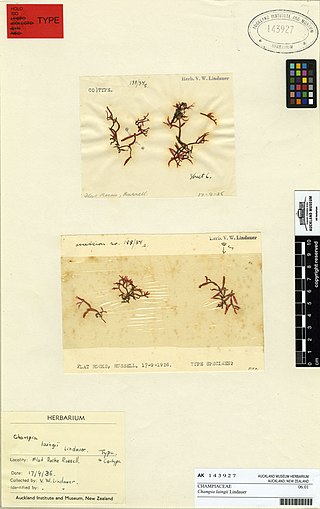
The Ulvophyceae or ulvophytes are a class of green algae, distinguished mainly on the basis of ultrastructural morphology, life cycle and molecular phylogenetic data. The sea lettuce, Ulva, belongs here. Other well-known members include Caulerpa, Codium, Acetabularia, Cladophora, Trentepohlia and Monostroma.

The sea lettuces comprise the genus Ulva, a group of edible green algae that is widely distributed along the coasts of the world's oceans. The type species within the genus Ulva is Ulva lactuca, lactuca being Latin for "lettuce". The genus also includes the species previously classified under the genus Enteromorpha, the former members of which are known under the common name green nori.

Ulva lactuca, also known by the common name sea lettuce, is an edible green alga in the family Ulvaceae. It is the type species of the genus Ulva. A synonym is U. fenestrata, referring to its "windowed" or "holed" appearance, Despite the name, it is not a lettuce

Ulvaria is a genus of green algae in the family Ulvaceae. It is similar to Ulva, but rather than being two cells thick, it is only one, despite its darker colour.

The genus Umbraulva, which is a green alga within the Ulvaceae family, was proposed by Bae and Lee in 2001. Three additional species, including U. kuaweuweu, which was subsequently transferred to another genus, have been added to the genus since it originally had the three species that were initially examined to form the genus. Umbraulva species grow upon hard substrates, and inhabit deep subtidal areas. Species within this genus are widely distributed, and have been identified in Asia, Europe, Hawaii, and New Zealand. The morphological traits of Umbraulva vary among species, but commonly, Umbraulva are macroscopic with olive green blades containing the photosynthetic pigment siphonaxanthin. The blades are flattened and ellipsoid in shape, or are narrow and oval shaped, with perforations and/or lobes present throughout the blade. As Umbraulva often appear very similar in morphology to closely related groups, the main manner in which Umbraulva was differentiated from related groups was through the divergence of ITS and partial SSU rDNA sequences from those of other Ulva species. Umbraulva is closely related to Ulva, which due to wide distributions, high carbohydrate levels, and a lack of lignin, is a good candidate for use in biofuel, bioremediation, carbon sequestration, and animal feed production.

Ulva intestinalis is a green alga in the family Ulvaceae, known by the common names sea lettuce, green bait weed, gutweed, and grass kelp. Until they were reclassified by genetic work completed in the early 2000s, the tubular members of the sea lettuce genus Ulva were placed in the genus Enteromorpha.
Ulva atroviridis is a species of blackish-green coloured seaweed in the family Ulvaceae that can be found in Port Nolloth of Cape Province in South Africa and in Namibia.
Ulva brevistipita is a species of blackish-green coloured seaweed in the family Ulvaceae that can be found in Australia and New Zealand.
Ulva bifrons is a species of blackish-green coloured seaweed in the family Ulvaceae that can be found in Sezimbra, Portugal, in France and Spain, and Balearic islands.

Ulva clathrata is a species of seaweed in the family Ulvaceae that can be found in such European countries as Azores, Belgium, Ireland, Netherlands, and the United Kingdom. It is also common in Asian and African countries such as Israel, Kenya, Mauritius, South Africa, Tanzania, Japan, Portugal and Tunisia. It has distribution in the Americas as well including Alaska, Argentina, Brazil, Cuba, Grenada, Hispaniola, and Venezuela. Besides various countries it can be found in certain gulfs, oceans and seas such as the Gulf of Maine and Gulf of Mexico, Indian Ocean and European waters.
Ulva crassa is a species of blackish-green coloured seaweed in Ulvaceae family that is endemic to New Zealand. The name comes from Latin meaning thick.
Ulva profunda is a species of seaweed in the family Ulvaceae that can be found in US state of Florida, India, and the island of Mauritius.
Ulva grandis is a species of seaweed in the family Ulvaceae that is endemic to Kiamari, Pakistan. The name comes from Latin meaning large.
Ulva polyclada is a species of seaweed in the family Ulvaceae that can be found in Australia and New Zealand.
Ulva ohnoi is a species of light-green coloured seaweed in the family Ulvaceae that is endemic to Japan.

Champia laingii is a marine red algal species endemic to New Zealand.







